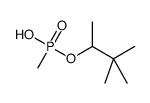pinacolyl methylphosphonate

pinacolyl methylphosphonate structure
|
Common Name | pinacolyl methylphosphonate | ||
|---|---|---|---|---|
| CAS Number | 616-52-4 | Molecular Weight | 180.18200 | |
| Density | 1.032 g/mL at 25ºC(lit.) | Boiling Point | 96-106ºC8 mm Hg(lit.) | |
| Molecular Formula | C7H17O3P | Melting Point | N/A | |
| MSDS | Chinese USA | Flash Point | 165 °F | |
| Symbol |

GHS07 |
Signal Word | Warning | |
|
On-line solid phase extraction-liquid chromatography-mass spectrometry for trace determination of nerve agent degradation products in water samples.
Anal. Chim. Acta 761 , 109-16, (2013) Three primary nerve agent degradation products (ethyl-, isopropyl- and pinacolyl methylphosphonic acid) have been determined in water samples using on-line solid phase extraction-liquid chromatography and mass spectrometry (SPE-LC-MS) with electrospray ionisa... |
|
|
Capillary ion electrophoresis screening of nerve agent degradation products in environmental samples using conductivity detection.
J. Chromatogr. A. 824(1) , 125-34, (1998) A method of detecting signature methylphosphonic acid (MPA) breakdown products of V and G nerve agents in environmental samples was developed using capillary ion electrophoresis with conductivity detection. The electrolyte (30 mM L-histidine, 30 mM 2-(N-morph... |
|
|
On-line solid-phase extraction liquid chromatography-continuous flow frit fast atom bombardment mass spectrometric and tandem mass spectrometric determination of hydrolysis products of nerve agents alkyl methylphosphonic acids by p-bromophenacyl derivatization.
J. Chromatogr. A. 833(2) , 169-79, (1999) For proof of the presence of chemical warfare agents sarin, soman and VX, a rapid, accurate and sensitive method which allows us to determine their hydrolysis products ethyl methylphosphonic acid, isopropyl methylphosphonic acid and pinacolyl methyl phosphoni... |
|
|
Derivatization of organophosphorus nerve agent degradation products for gas chromatography with ICPMS and TOF-MS detection.
Anal. Bioanal. Chem 388(4) , 809-23, (2007) Separation and detection of seven V-type (venomous) and G-type (German) organophosphorus nerve agent degradation products by gas chromatography with inductively coupled plasma mass spectrometry (GC-ICPMS) is described. The nonvolatile alkyl phosphonic acid de... |
|
|
Detection of degradation products of chemical warfare agents by highly porous molecularly imprinted microspheres.
Analyst 133(5) , 588-95, (2008) The multiplication of terrorist actions in the recent events is alarming and the detection of chemical warfare agents (CWAs) has become one of the highest research priorities in the fields of security and public health. The biomimetic properties of molecularl... |
|
|
Inhibition of adenylyl cyclase by acyclic nucleoside phosphonate antiviral agents.
J. Biol. Chem. 274(49) , 34742-4, (1999) Acyclic derivatives of adenine, known as highly effective nucleotide analogs with broad spectrum antiviral activity, were evaluated for potential cross-reactivity with adenylyl cyclases, a family of membrane-bound enzymes that share putative topologies at the... |
|
|
pH-dependent interactions of indinavir and lipids in nanoparticles and their ability to entrap a solute.
J. Pharm. Sci. 97(2) , 931-43, (2008) We have investigated the ability of lipid-indinavir particles composed of 3-to-1 lipid-drug molar ratio to encapsulate an aqueous marker calcein and anti-HIV drug (3)H-phosphonylmethoxypropyl-adenine (PMPA). Even at a high density of indinavir associated to l... |
|
|
New reverse transcriptase inhibitors.
Adv. Exp. Med. Biol. 458 , 183-97, (1999)
|
|
|
Acyclic phosphonate nucleotides and human adenylate kinases: impact of a borano group on alpha-P position.
Nucleosides Nucleotides Nucleic Acids 27(4) , 319-31, (2008) Adenylate kinases are involved in the activation of antiviral drugs such as the acyclic phosphonates analogs PMEA and (R)PMPA. We examine the in vitro phosphorylation of PMEA and PMPA bearing a borano- or a H- group on the phosphorus atom. The alpha-borano or... |
|
|
Direct hapten-linked competitive inhibition enzyme-linked immunosorbent assay (CIELISA) for the detection of O-pinacolyl methylphosphonic acid.
Analyst 137(2) , 406-13, (2012) Immunoassay detection of O-pinacolyl methylphosphonic acid (PMPA) employing direct coating of N-2-aminoethyl-O-pinacolyl methylphosphonate (hapten B) on microtiter plates is reported. Coating was achieved by covalently linking hapten B to a glutaraldehyde (GA... |